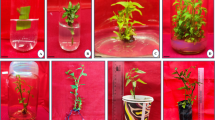Abstract
A liquid meristematic root primordia culture (RPC) of Solanum lycopersicoides Dun. based on persistent rhizogenesis in a modified Murashige and Skoog (1962) medium supplemented with NAA (15 mg·l−1) or 2,4-D (1 mg·l−1) was described. The meristematic clumps (2–3 mm in diameter) originating from NAA supplemented medium were capable of regenerating plants through the callus stage (up to 70 %). Efficient direct plant regeneration (up to 21 %) was possible from numerous single globular-shaped root primordia (RP) structures liberated from the parental aggregates in 2,4-D supplemented proliferation medium without NH4NO3 and with a 2.5 fold increase in KNO3. The RP converted into plantlets (artificial seedlings) on solid or liquid media without growth growth regulators through the unipolar followed by the mace-shaped bipolar structure stages. The use of apical shoot bud, root apices or root segments as a primary explants brought about RPC induction and plant regeneration. The plants derived from 2 years old culture were phenotypically identical to their parental S. lycopersicoides plants and possessed the same ploidy.
Similar content being viewed by others
Abbreviations
- 2,4-D:
-
dichlorophenoxy acetic acid
- BA:
-
6-benzyladenine
- NAA:
-
naphthalene acetic acid
- RP:
-
root primordia
- RPC:
-
root primordia culture
- SMS:
-
modified Murashige and Skoog (1962) medium for Solanum lycopersicoides
References
Akita M., Ohta Y. 2000. The effect of Tiron, a water soluble radical scavenger, on growth, morphology and alkaloid content of adventitious roots in Atropa belladonna. Plant Cell Rep. 19: 705–709.
Bensaddek L., Gillet F., Saucedo J.E.N., Fliniaux M-A. 2001. The effect of nitrate and ammonium concentrations on growth and alkaloid accumulation of Atropa belladonna hairy roots. J. Biotechnol. 85: 35–40.
Bourgaud F., Gravot A., Milesi S., Gontier E. 2001. Production of plant secondary metabolites: a historical perspective. Plant Sci. 161: 834–851.
Burg H.C.J., Sree Ramulu K., Bredemeijer G.M.M., Roest S., Dijkhuis P., Van Hoogen J.J., Houwing A. 1989. Patterns of phenotypic and tuber protein variation in plants derived from protoplasts of potato (Solanum tuberosum L. cv. Bintje). Plant Sci. 64: 113–124.
Burza W., Malepszy S. 1995. Direct plant regeneration from leaf explants in cucumber (Cucumis sativus L.) is free of stable genetic variation. Plant Breed. 114: 341–345.
Butcher D.N., Street H.E. 1964. Excised root culture. Bot. Rev. 30: 513–586.
Danckwardt-Lillienstrom C. 1957. Kinetin induced shoot formation from isolated roots of Isatis tinctoria. Physiol. Plant. 10: 794–797.
Evans D.A., Sharp W.R. 1983. Single gene mutations in tomato plants regenerated from tissue culture. Science 221: 949–951.
Fujishige I., Tanaka R., Taniguchi K. 1996. Efficient isolation of non-chimeric tetraploids artificially induced in a stable culture of Haplopappus gracilis. Theor. Appl. Genet. 92: 157–162.
Guivarc’h A., Boccara M., Prouteau M., Chriqui D. 1999. Instability of phenotype and gene expression in long-term culture of carrot hairy root clones. Plant Cell Rep. 19: 43–50.
Halperin W. 1966. Alternative morphogenetic events in cell suspensions. Am. J. Bot. 53: 443–453.
Hamill J.D., Parr A.J., Rhodes M.J.C., Robins R.J., Walton N.J. 1987. New routes to secondary products. Bio/Technology 5: 800–804.
Handley L.W., Sink K.C. 1985. Plant regeneration of Solanum lycopersicoides Dun. from stem explants, callus and suspension cultures. Plant Cell Tiss. Org. Cult. 5: 129–138.
Idei S., Kondo K. 1998. Effects of NO 3 /− and BAP on organogenesis in tissue-cultured shoot primordia induced from shoot apices of Utricularia praelonga St. Hil. Plant Cell Rep. 17: 451–456.
Komai F., Okuse I., Harada T. 1996. Somatic embryogenesis and plant regeneration in culture of root segments of spinach (Spinacia oleraceae L.). Plant Sci. 113: 203–208.
Laublin G., Saini H.S., Cappadocia M. 1991. In vitro plant regeneration via somatic embryogenesis from root culture of some rhizomatous irises. Plant Cell Tiss. Org. Cult. 27: 15–21.
Marin M.L., Marin J.A. 1998. Excised rootstock roots cultured in vitro. Plant Cell Rep. 18: 350–355.
Murashige T., Skoog F. 1962. A revised medium for rapid growth and bioassay with tobacco tissue culture. Physiol. Plant. 15: 473–497.
Norton J.P., Boll W.G. 1954. Callus and shoot formation from tomato roots in vitro. Science 119: 220–221.
Pijnacker L.P., Ferwerda M.A. 1990. Effect of sucrose on polyploidization in early callus cultures of Solanum tuberosum. Plant Cell Tiss. Org. Cult. 21: 153–157.
Seelinger T. 1957. Über die Kultur isolierter Wurzel die Robinie (Robinia pseudoacacia L.). Flora 144: 47–83.
Tanaka R., Ikeda H. 1983. Perennial maintenance of Haplopappus gracilis (2n=4) by shoot tip cloning. Jpn. J. Genet. 58: 65–70.
Tylicki A., Burza W., Kuraś M., Dziadczyk E., Malepszy S. 2000 a. Structural and ultrastructural analysis of root primordia in vitro cultures (RPC) of Solanum lycopersicoides Dun. Plant Sci. 156: 73–83.
Tylicki A., Burza W., Kuraś M., Malepszy S. 2000 b. A new way of achieving plant regeneration of Solanum lycopersicoides Dun. From root primordia culture. Plant Cell. Rep. 19: 837–844.
Uozumi N., Kobayashi T. 1995. Artificial seed production through encapsulation of hairy root and shoot tips. In: Bajaj YPS, ed. Biotechnology in agriculture and forestry, Vol 30. Somatic embryogenesis and synthetic seed I. Springer, Berlin, Heidelberg, New York, 170–180.
Uozumi N., Kato Y., Nakashimada Y., Kobayashi T. 1992. Production of artificial seed from horseradish hairy root. J. Ferment. Bioeng. 74: 21–26.
Vourela P., Oksman-Caldentey K-M., Lipponen J., Hiltunen R. 1993. Spontaneous somatic embryogenesis and plant regeneration from root culture of Peucedanum palustre. Plant Cell Rep. 12: 453–456.
Yu K-W., Gao W., Hahn E-J., Paek K-Y. 2002. Jasmonic acid improves ginsenoside accumulation in adventitious root culture of Panax ginseng C. A. Meyer. Biochem. Eng. J. 11: 211–215.
Author information
Authors and Affiliations
Corresponding author
Rights and permissions
About this article
Cite this article
Burza, W., Dziadczyk, E., Tylicki, A. et al. Characterisation of Solanum lycopersicoides Dun. root primordia culture with plant recovery. Acta Physiol Plant 25, 385–394 (2003). https://doi.org/10.1007/s11738-003-0020-5
Received:
Accepted:
Issue Date:
DOI: https://doi.org/10.1007/s11738-003-0020-5




